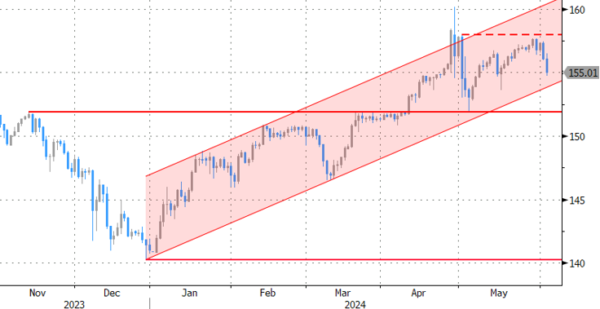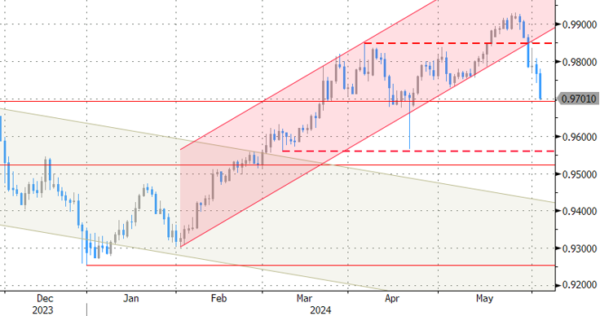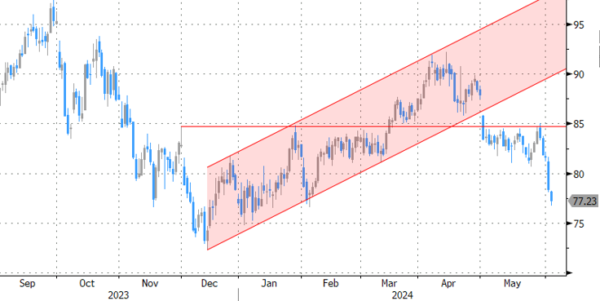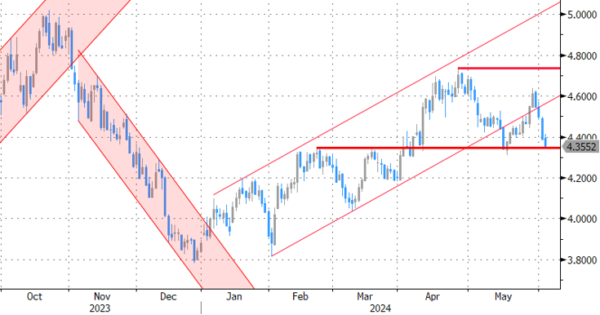Markets
Markets remained stuck in yesterday’s (US) trading mode in absence of important EMU eco data or ECB talk (silent period ahead of Thursday’s meeting). That means a bid for core bonds as the (US) growth part of the equation enters the spotlight. Investors yesterday zoomed in on significantly declining new orders in the US manufacturing ISM. The demand side of the story is one out of three factors pulling oil prices lower as well. The other ones being supply (OPEC+ will scale back production cuts after September) and technical reasons (Brent drops below $80.5/ support area). The downleg in oil prices continues today with Brent crude trading near $76/b from $77/b. Support coming from the YTD low kicks in at $74.38/b. US Treasuries and German Bunds already trade higher again in the run-up to April JOLTS job openings. An unexpected decline of openings only reinforced this momentum. US yields lose 5 to 6 bps with the belly of the curve outperforming the wings. The US 2-yr (4.78%) and 10-yr yield (4.36%) are sliding towards the mid-May lows of respectively 4.70% and 4.31%. German yields lose 4.5 to 7 bps in a similar curve move. We retain May German unemployment data which showed a 25k increase (vs 7k expected). It matches the third highest monthly rise since July 2022. The German unemployment rate held steady at 5.9%. The Federal Labor Agency said that the traditional spring recovery hasn’t really taken off this year. In FX space, EUR/USD (1.0875) moved back into more familiar territory after yesterday’s first close above 1.09 since March 20. The jury remains out given this week’s remaining US eco data (ADP, ISM services, payrolls) and ECB policy meeting. The trade-weighted dollar similarly bounced off the 104 support area for now. USD/JPY is exception to the rule as core bond yields decline. The pair dips from 156+ to 155. Finance Minister Suzuki this morning commented on the country’s interventions to counter excessive FX moves ‘which were driven by speculation’. He believes that “they had a certain effect”. Sources close to the Bank of Japan also suggested that the central bank will likely discuss the reduction of bond purchases as early as the next, June 14, policy meeting. They currently buy at a pace of roughly JPY 6tn per month. Any shift will be gradual according to the sources. Japanese yields briefly responded to the Bloomberg article but eventually followed today’s global market move.
News & Views
Swiss inflation rose 0.3% m/m in May. The as-expected outcome matched last month’s pace and kept the yearly figure at 1.4%. Switzerland’s Federal Statistical Office attributed the increase to housing rentals (amid the rise of a key reference rate) and international package holidays as well various fresh vegetables and petrol. Core inflation (excluding fresh and seasonal products, energy and fuel) rose 0.2% m/m and 1.2% y/y – slightly below the 1.3% consensus. That prompted a kneejerk move lower of the Swiss franc against the euro. But CHF quickly overcame this weakness to even become one of the top G10 performers today. EUR/CHF drops towards the 0.97 big figure, the lowest since mid-April, in lockstep with core bond yields even as money markets have raised bets to >50% for a rate cut by the Swiss National Bank on June 20 in the wake of the CPI release. Market sentiment is fragile but not outright risk-off as to add to current CHF strengthening. In a speech last week, SNB president Jordan did say the franc had weakened more than enough after EUR/CHF hit 0.99+ from +0.93 at the beginning of the year. His comments triggered a turnaround that apparently has strong legs and more room to run.
Czech nominal wages grew 7% y/y in the first quarter of the year, easing only marginally from an upwardly revised 7.1% a quarter earlier. In real terms, wages shot up 4.8% y/y with Q4’s negative growth reduced from -1.2% to just -0.5%. It’s the first positive real wage increase in nine quarters. It could turn out to be a boost for consumer spending and therefore help kickstart the currently sluggish economic recovery. Q1 GDP numbers were revised down from 0.5% to 0.3% last week. Today’s outcome was 0.6 ppts higher than the Czech National Bank’s spring forecast for both nominal and real wage growth. It supports their hawkish stance which will most likely end up in the central bank cutting at a 25 bps clip from June on instead of the 50 bps pace so far in 2024. Czech swap rates add up to 3 bps at the front end of the curve, parting ways with core markets and regional peers. The CZK tried to eke out a gain at first but succumbed eventually. EUR/CZK moved from 24.66 to 24.76.
Graphs
USD/JPY: JPY and CHF benefit from lower core bond yields

EUR/CHF: SNB Jordan’s CHF comments proved to be a turning point for the swiss franc

Oil prices: triple whammy of demand concern, more supply and deteriorating technical picture

US 10-yr yield approaches 4.31% support level with key important US eco data still to come this week










